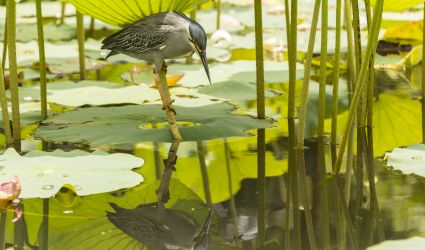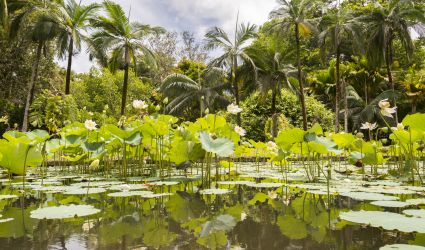Environment, Flora & Fauna
Mauritian Nature
Mauritius is rightfully known the world over for its beautiful sandy beaches and the shimmering turquoise water that surrounds the island. What many people miss, however, is that this stunning island has much more to offer visitors, with a varied natural world encompassing a range of landscapes, dense rainforests, looming mountain ranges, roaring waterfalls, and unique flora and fauna that cannot be found anywhere else in the world.
 A spectacular view of the incredible beach and Morne Brabant
A spectacular view of the incredible beach and Morne Brabant
Away from the beaches, some highlights include the Black River Gorges National Park, the stunning seven colours of earth in the south of the island, and the delightful Tamarind and Rochester waterfalls. For biodiversity and conservation efforts, the islands of Île d’Ambre and the Île aux Aigrettes are worth a look.
With this much nature on offer, it follows that the country is also a hiker’s paradise, with routes of differing difficulty offering incredible views of the country’s landscapes and of the surrounding Indian Ocean.
Mauritian Landscapes
Mauritius’ landscape varies from region to region, but the volcanic origins of this Indian Ocean island are always present. With flat coastal areas rising to a central plateau some 700 metres above sea level, the island has rocky mountain peaks, sprawling sugar cane fields, volcanic craters, and of course beautiful beaches around the coasts.
 The stunning Flic en Flac beach is one of the longest on Mauritius
The stunning Flic en Flac beach is one of the longest on Mauritius
The south of the island rises particularly sharply from the ocean into rocky, mountainous peaks, while the north of the island lies mostly flat, rising very gradually out of the ocean and up to the plateau. This region is also well-known for its sugar cane fields, which used to dominate the landscape entirely, but these days are less vital to the everyday survival of the Mauritian economy, and so the prevalence of sugar cane has also dropped.
Mountains
While not as tall as many of the world’s mountain ranges, the mountains on Mauritius provide imposing, picturesque contrasts to the rest of the island. Rising to a height of 828 metres (2717 ft) is Le Piton de la Petite Rivière Noire, the tallest mountain on the island. Other notable mountains include Pieter Both next to Port Louis, Le Pouce (the ‘thumb’), the Corps de Garde (next to Rose Hill), and the Piton du Milieu, which rises in the centre of the island, offering a wonderful view of (almost) the entire island.
 Numerous myths and legends revolve around the incredible shape of the Pieter Both mountain
Numerous myths and legends revolve around the incredible shape of the Pieter Both mountain
Perhaps the most famous mountain on Mauritius is, however, Le Morne Brabant in the south-west of the island. Famous for its steep, rocky surface, it contrasts enormously with the flat, widespread bay in front of it. The mountain is also a UNESCO World Heritage Site for its historic links to the slave trade on Mauritius. Runaway slaves used to shelter in the mountain’s many caves and crevices. These days, it serves as a natural memorial of all of the lives that were affected by the slave trade.
 This impressive mountain has been a UNESCO World Heritage Site since 2008
This impressive mountain has been a UNESCO World Heritage Site since 2008
Volcanic Craters
Despite its volcanic origins, there are very few remaining relics of Mauritius’ volcanic past, with just a few craters, Trou Kanaka, Grand Bassin, Trou aux Biches, and Bassin Blanc lining the island.
 The crater lake of Grand Bassin is the most famous Hindi pilgrimmage on Mauritius
The crater lake of Grand Bassin is the most famous Hindi pilgrimmage on Mauritius
Rivers and Waterfalls
Grande Rivière Sud-Est is the longest river on the island, and joins the ocean close to the Ile aux Cerfs, while other rivers cut imposing gorges into the landscape, including the Rivière Noire.
But Mauritius is perhaps more commonly known for its waterfalls, with multiple spectacular sites spread across the island. Some of them can be hard to get to due to their isolated locations, but are well worth the effort thanks to their wild scenery.
Tamarind Falls
Also known as the ‘Sept Cascades’ or the ‘Seven Waterfalls’, the Tamarind Falls is a uniquely-impressive waterfall in the southern half of Mauritius, with multiple waterfall streams crossing over and falling together, surrounded by beautiful plant and animal species.
 The Tamarind Waterfalls consist of seven smaller waterfalls that fall in one incredible natural spectacle
The Tamarind Waterfalls consist of seven smaller waterfalls that fall in one incredible natural spectacle
Chamarel Waterfall
The tallest waterfall in Mauritius is the Chamarel Waterfall, which falls around 100 metres, surrounded by stunning rocky, jungle scenery. The stunning sight is so well-known that it is a common motif for photographers who visit the country.
Rochester Falls
Far in the south of Mauritius lie the Rochester Falls, which is one of the wildest waterfalls on the island. With sharp cliff faces, sturdy rocky formations, and a powerful, imposing waterfall, it is particularly popular amongst visitors looking to jump into the water for a quick dip.
 You can go swimming with an incredible backdrop at the wild Rochester Falls
You can go swimming with an incredible backdrop at the wild Rochester Falls
Alexandra Falls
Located in the Black River Gorges National Park, the Alexandra Falls are another impressive feature of the Mauritian landscape, cutting through the lush flora of the region in an imposing manner.
Coastline
Almost all of the 160 kilometres (100 miles) of Mauritius’ coastline is protected by coral reefs, creating shallow, calm lagoon conditions on many of the island’s beaches. The south of the island has more gaps in the coral reef, and so experiences stronger currents than the rest of the island.
 There are numerous incredible beaches to discover on Mauritius.
There are numerous incredible beaches to discover on Mauritius.
The coasts are also fringed by beautiful sandy beaches, a fact that turned Mauritius into the popular tourist destination it is today. Meanwhile, small islands line the coasts too, including the Coin de Mire, Île Ronde, Île Plate, and the Île aux Cerfs, which is a popular tourist spot in the east of Mauritius.
Flora and Fauna
Like other isolated islands such as the Seychelles or Galapagos, Mauritius is home to a unique variety of plant and animal species, many of which cannot be found elsewhere in the world. Unfortunately, humans have badly impacted the ecosystem on Mauritius, with animals providing food for settlers and large swaths of trees being felled for exports. The biodiversity of the island remains impressive, but the damaging effect of human settlement should not be forgotten.
Fauna
The Dodo
Perhaps the best, or worst, example of human influence is the dodo. This extinct bird species once thrived in Mauritius; with no predators and little competition, the bird even lost its ability to fly through evolution. Upon arrival, human settlers saw the dodo as an easy source of food, and within two hundred years, the dodo population had been wiped out. The introduction of alien species, again through human activity, only worsened matters, with dodo eggs feeding new arrivals such as rats and monkeys.
 Before humans settled on Mauritius, the island was home to the Dodo
Before humans settled on Mauritius, the island was home to the Dodo
Other Species
Tortoises and turtles were also badly affected by the arrival of humans, and their populations suffered greatly too. Thankfully, not all of Mauritius’ rare bird species were killed off, with species such as the Mauritius kestrel, the echo parakeet, and the pink pigeon still being present to this day. Besides that, sparrows, paradise flycatchers, doves, and tropicbirds (amongst others) can all be found on Mauritius, with many having been introduced over the years.
The Mauritian fruit bat (also called the golden bat) is the island’s only indigenous mammal species. Due to human influence, monkeys, hares, and deer can these days be found on Mauritius too. In terms of reptiles, there are a few species of snake, but none of which are poisonous, and the endemic telfair skink.
 You can discover small monkeys such as this one on Mauritius
You can discover small monkeys such as this one on Mauritius
The underwater world around Mauritius is thriving particularly well, with the warm waters of the Indian Ocean providing excellent conditions for colourful corals to grow. Giant clams, sponges, anemones, and a variety of colourful fish live amongst the coral, as do larger species such as octopuses and giant eels.
Flora
The island’s tropical climate is ideal for many plant species, with colourful fruits and flowers thriving. Bananas, pineapples, guavas, mangoes, and litchis are just some of the wonderful fruits that grow here, while orchid, anthuriums, frangipani, lilac, and bougainvillea count amongst the flower species. Perhaps the most abundant plant on Mauritius is the sugar cane crop, which used to cover the vast majority of arable land on the island, and in the past played a key role in the Mauritian economy.
As with the unfortunate dodo bird, the initial settlers on Mauritius stripped the island of much of its rainforest, with teak, ebony, and colophane trees all being chopped down for wood or exports. These days, the Black River Gorges National Park contains the majority of the island’s trees, including the common colophane trees, some of which are thought to be thousands of years old. Other tree species include banyan trees, filao (casuarina), and fruit trees.
 Ancient trees rise up in the Black River Gorges National Pa
Ancient trees rise up in the Black River Gorges National Pa
Conservation Efforts
The beautiful Sir Seewoosagur Ramgoolam Botanical Garden, located near to Pamplemousses, is one of the most popular attractions on the island, but is also important for plant conservation efforts. The gardens are home to exotic plants such as palms, fruit trees, ebony trees, spices, and more.
Birds are taken care of at the Government Aviary at Rivière Noire. Here, rare bird species such as the pink pigeon and the Mauritius kestrel are protected and bred in order to increase numbers in the wild. Thanks to the efforts of the centre, hundreds of new birds have been released into the wild in the last forty years.
The Mauritian government has also worked to protect parts of the country by naming areas nature reserves, including the Black River Gorges National Park, the Île aux Aigrettes, and the Bras d’Eau National Park.












